In the Wednesday Night Rivalry Capitals vs. Penguins matchup, at one point in the game, when the Brooks Laich, Eric Fehr and Joel Ward line was pinning the Penguins in their own zone on the forecheck, NHL on NBCSN’s Pierre McGuire said the three hard-nosed forwards were becoming the best third line in the NHL.
But are they even a third line? While many people understandably believe Marcus Johansson, Evgeny Kuznetsov and Troy Brouwer are the second line, as they are the more prototypical type of players that are generally featured on a second line, that line might actually technically be the third. Within the locker room, Barry Trotz writes the lineup on a dry and erase board. Russian Machine Never Break’s locker room correspondent Chris Gordon snagged a photo of it just before Christmas.
The third line is the second line. For real. pic.twitter.com/ns7RSVzvrR
— Chris Gordon (@Chris_Gordon) December 23, 2014
In fact, the even strength time on ice numbers support the fact that Laich, Fehr and Ward might be the second line. Here are the even strength time on ice numbers from War On Ice, from January 4th (when Kuznetsov cemented himself as the center between Johansson and Brouwer) to the Pittsburgh game on January 28th.
| Player | ES TOI/GP |
| Ward | 12.9 |
| Fehr | 12.4 |
| Laich | 12.0 |
| Kuznetsov | 11.4 |
| Johansson | 11.2 |
| Brouwer | 11.0 |
Ok, fine. They are all pretty close to one another. But as you can see, Laich, Fehr and Ward are all ahead in even strength ice time to Johansson, Kuznetsov and Brouwer
Even though Ward, Fehr and Laich are technically a second line, they are still deployed more as a third line, seeing more defensive zone situations and facing against the leagues top opponents. Here’s a visual, showing the six players offensive and defensive zone starts, time on ice percentage of competition and their Fenwick percentages.
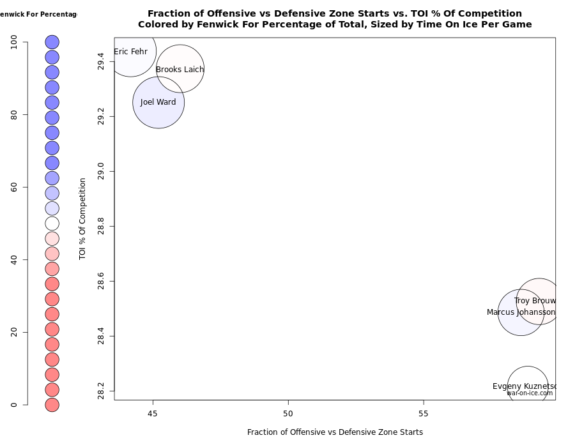
As we can see, Ward, Fehr and Laich are clearly being utilized as a defensive forward unit, typical duties of a third line.
So, what is this line? Is it a second or a third line?
Let’s take a look at each player individually.
Brooks Laich
Laich has been a part of the Capitals for 11 seasons now, more than any other current Cap. After his first full two seasons of his career, Laich became an offensive force. In three straight seasons, Laich scored more than 20 goals, primarily playing as a third line player in Bruce Boudreau’s high powered offensive style. Even when Dale Hunter was named the head coach, Laich was still a reliable goal scorer, putting up 16 goals in the 2011-2012 season.
While nagging groin injuries have taken Laich out of many games over the past three seasons, it is evident that Laich is being utilized more for his defensive skills than his offensive skills. After finishing 11th in the Selke trophy voting in the 2010-2011 season, Laich has been utilized more as a top defensive forward for the Capitals.
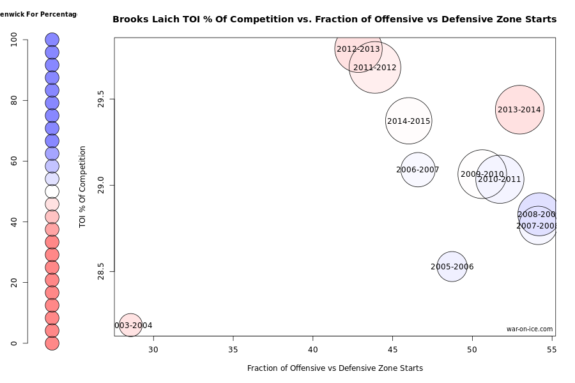
Laich has faced his toughest competition of his career over the passed four seasons, and he is seeing far more defensive zone starts now than he had when he was relied on to score 20 goals a season.
Interesting enough, while Laich is only seeing 11.9 even strength minutes per game, his lowest since his clear third line role in the 2008-2009 season, he is still averaging more goals per 60 minutes (0.9) of his play this season than any other season of his career. And his 2 points per 60 minutes of his play is the second highest of his career.
Why is he only on pace for significantly less total points than he had in the past? Because his power play time is significantly lower. In fact, it’s practically non-existent. His .4 minutes of power play time per game is the lowest total he’s had since his four game rookie season. In the season where Laich scored his career high in points, the 2009-2010 season, where he had 59 points, 21 of them came on the power play.
Laich’s role is a bit different now than it was when he first entered the league, though it may be more beneficial to the team if he sees a bit more offensive opportunities against weaker competition.
Eric Fehr
Fehr has almost an identical career path through the Capitals that Laich has. Fehr has been primarily a third line player for the Capitals. But Fehr is primed for his best season yet, and it is coming during his most difficult season of his career.
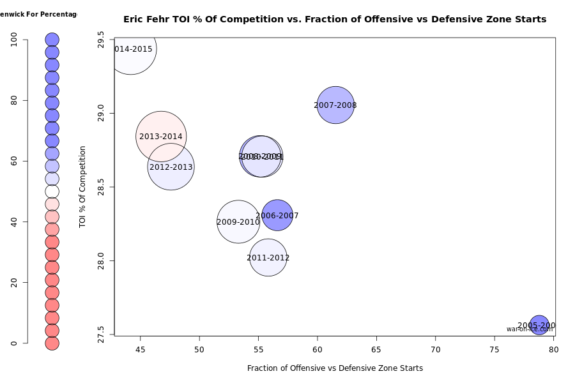
Fehr is not only seeing the majority of his starts in the defensive zone, but he is also facing his toughest competition. Even more impressive, Fehr already has as many even strength goals (13) this season than he had last year. He is on pace to have a career high in goals this season, just six goals away from his career best of 21.
Not only is Fehr’s season impressive, but he’s playing a totally different position at center than he has in the past, when he was a right wing. Fehr has obviously transitioned nicely. He had some experience last year at center, but this year it appears he has permanently made the transition. He’s producing points, and he’s winning on the face off dot. Prior to the 2013-2014 season, Fehr won a total of two face offs on 11 opportunities. This year, Fehr has won 238 face offs, good for 53 percent success rate.
The only concern we have to think about with Fehr is that his shooting percentage this season is very much unsustainable. He is currently scoring on 16.5 percent of his shots, which is a career high. Since Fehr came into the league full time in the 2009-2009 season, he has shooting percentage of 10.1 percent. That’s still above average, but much, much lower than his current 16.5 percent. That being said, he is still on pace to have a career high in shots taken. If he can continue to ride his high success rate, this will quite easily be Fehr’s most successful season ever.
Joel Ward
Oddly enough, this season, Ward is being deployed in more offensive situations than every season. But, he’s still on par in zone starts with Fehr and Laich. Why?
Well, for starters, the Capitals this season have been getting more offensive zone starts (53.1 percent) as a whole. In fact, that 53.1 percent offensive zone starts is the highest amount of offensive zone starts since the 2008-2009 season. The Capitals are possessing the puck more and creating more offensive chances for themselves under Barry Trotz. So, even if a player is deployed as a defensive player, he still will see obviously see more opportunities in the offensive zone if the team as a whole gets a lot of opportunities in the offensive zone.
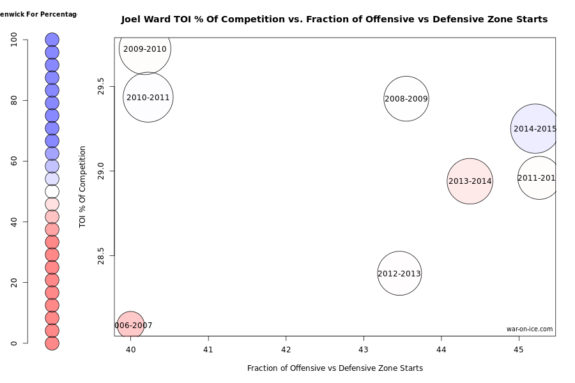
Secondly, Ward can be trusted offensively more so than he had in the past. He’s coming off a 20 goal season, a first for Ward, and he’s right back on track to do so again, scoring .9 goals per 60 minutes of his play, just .1 less than he recorded last year.
But unlike Fehr and Laich, Ward does see time on the power play. In fact, he’s adding 1.4 minutes per game. In fact, Ward has already added two power play goals and two assists this season. He is, however, seeing time on the second power play unit, he’s getting less time not he power play than he had in the past two seasons, and he’s not scoring as often as he had in the past.
Is Ward going to get 20 goals again? He’s cutting it close, but he certainly has a good opportunity to do so with 11 on the season. He’s also shooting at a 12.2 percent success rate, which is much closer to his career average. And, like Fehr, Ward is shooting the puck more. And the more you shoot, the more opportunities you create for yourself.
Is It A Second Line, Or A Third Line?
It’s either a slightly below average second line, or a really, really good third line.
Domenic Galamini recently developed what he calls a Horizontal Evaluative Rankings Optics (HERO charts). These charts look at important player evaluation factors, like Corsi and point production, but take away the many factors of usage in order to determine raw skill. Galamini gives a good explanation of the calculation process here. Basically, a guy like Alex Ovechkin is obviously going to play against top competition, in offensive zones, with really good line mates, like Nicklas Backstrom. But, is it fair to match a guy like Fehr with Ovechkin, when Fehr also plays against top competition, starting primarily in defensive zones, with less skilled line mates? Obviously no. These charts strip away those factors.
The way the chart is set up also gives us a good idea of how individual players stack against all other NHL players. With these charts, we can see the line each player should be playing on. It’s obviously not entirely conclusive, but still gives us a pretty good estimate. Here’s the HERO charts for Laich, Fehr and Ward. This data is from the 2012-2013 onward.
Laich
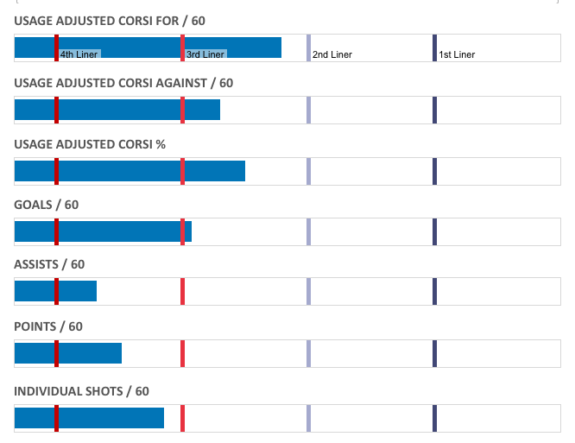
Fehr
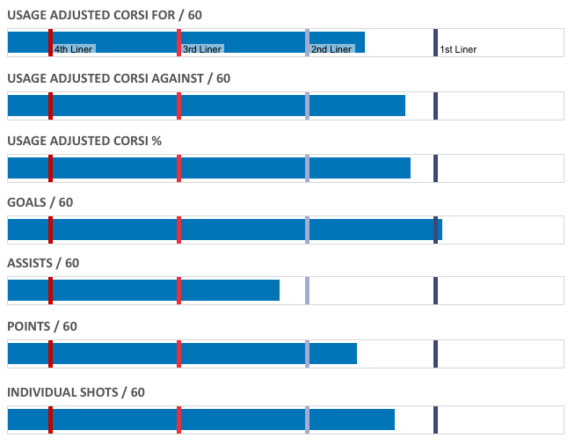
Ward
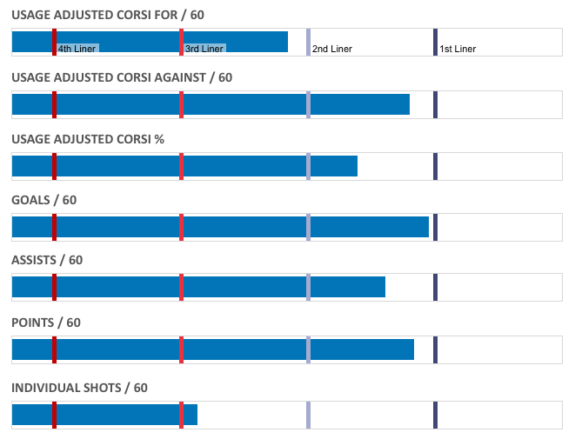
So, as we can see, Laich can be trusted as a third line winger based on his possession. However, even though he is driving possession like a third liner, he is not scoring at a third line rate. While this may have to do with the fact that Laich has missed a lot of time over the passed couple of seasons due to injury, it also might not.
Fehr can actually fully be trusted as a second line player. He drives possession and defends well for a second liner. He is also shooting the puck as an average second liner would, but he’s scoring at an extremely high rate. This once again hints that his currently shooting percentage of 16.5 percent is simply not sustainable.
Ward is very similar to Fehr. He defends the puck extremely well, and his point production is excellent. But, much like Fehr, Ward’s goal production isn’t matching very well with the amount of shots he’s taking.
While both Fehr and Ward may be producing at a higher rate offensively than they should be, you could still realistically expect the two players would preform better offensively than the average third line player. And while Laich isn’t performing at the offensive rate you would expect from a second liner, he is still embracing that defensive role that is expected from him this year, based on his offensive zone deployments.
So yes, Pierre, it is the best third line in the NHL. If they can even be called a third line.